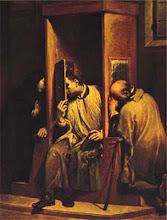One of the Twelve, who was called Judas Iscariot,
went to the chief priests and said,
“What are you willing to give me
if I hand him over to you?”
They paid him thirty pieces of silver,
and from that time on he looked for an opportunity to hand him over.
On the first day of the Feast of Unleavened Bread,
the disciples approached Jesus and said,
“Where do you want us to prepare
for you to eat the Passover?”
He said,
“Go into the city to a certain man and tell him,
‘The teacher says, My appointed time draws near;
in your house I shall celebrate the Passover with my disciples.'"
The disciples then did as Jesus had ordered,
and prepared the Passover.
the disciples approached Jesus and said,
“Where do you want us to prepare
for you to eat the Passover?”
He said,
“Go into the city to a certain man and tell him,
‘The teacher says, My appointed time draws near;
in your house I shall celebrate the Passover with my disciples.'"
The disciples then did as Jesus had ordered,
and prepared the Passover.
When it was evening,
he reclined at table with the Twelve.
And while they were eating, he said,
“Amen, I say to you, one of you will betray me.”
Deeply distressed at this,
they began to say to him one after another,
“Surely it is not I, Lord?”
He said in reply,
“He who has dipped his hand into the dish with me
is the one who will betray me.
The Son of Man indeed goes, as it is written of him,
but woe to that man by whom the Son of Man is betrayed.
It would be better for that man if he had never been born.”
Then Judas, his betrayer, said in reply,
“Surely it is not I, Rabbi?”
He answered, “You have said so.”
he reclined at table with the Twelve.
And while they were eating, he said,
“Amen, I say to you, one of you will betray me.”
Deeply distressed at this,
they began to say to him one after another,
“Surely it is not I, Lord?”
He said in reply,
“He who has dipped his hand into the dish with me
is the one who will betray me.
The Son of Man indeed goes, as it is written of him,
but woe to that man by whom the Son of Man is betrayed.
It would be better for that man if he had never been born.”
Then Judas, his betrayer, said in reply,
“Surely it is not I, Rabbi?”
He answered, “You have said so.”
(Mt 26, 14-25 NAB)
How often do each of us deny our betrayal of Christ? How often have we looked up to Christ suffering on the crucifix in Church and prayed: "Surely not I Lord."
Surely it is someone else who has committed the more grievous offense! Surely it not I who deserves to be judged harshly! Surely You love me and You will save me though I am a sinner! Surely I need You, my Lord! And Christ says, "That is it." Beckoning us, He says: "Acknowledge your sinfulness, repent and live your lives in utter reliance upon Me, keeping to a life as I have commanded, and you shall be saved."
That salvation is coming. Though now in darkness, we know the glory of Easter will dawn upon us from on high on Easter morning.
We need only to lay ourselves open to Christ as he has embraced us from the cross. Arms wide spread ready to embrace us even as He empties Himself for our salvation. Persevere in this last period of darkness before the dawn! Place all your faith in Christ!



































